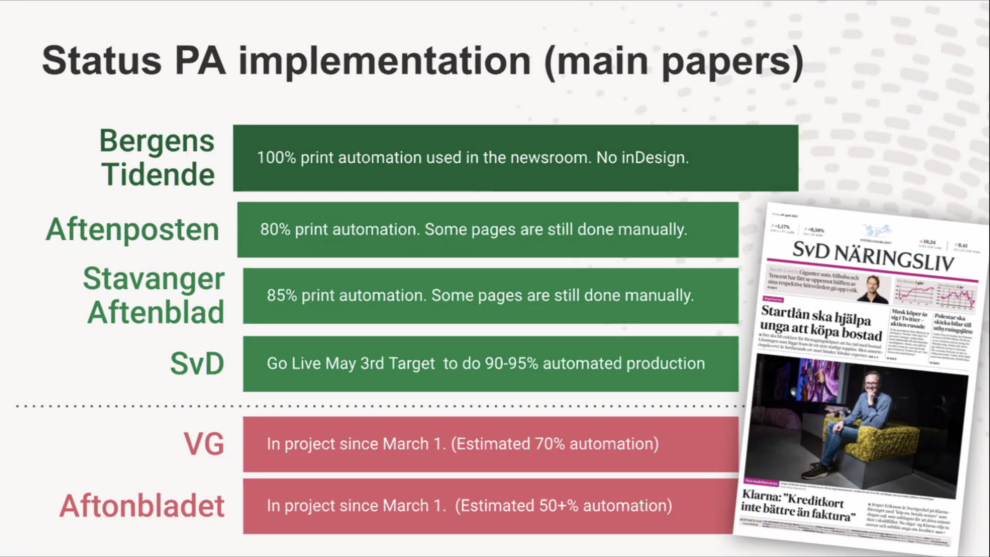|
Getting your Trinity Audio player ready...
|
Newsrooms are quickly becoming the drivers of change and innovation for publishers. Recognising the potential behind technology has given newsrooms the chance to automate and innovate. They can now give greater attention to their content.
As we heard from Tommi Heikkonen of Fiare at the WAN-IFRA Newsroom Summit, it is a positive publishing shift that innovation projects with external partners are becoming more editorial team led as opposed IT department led. So, we take a look at some of the latest newsroom innovations from the WAN-IFRA Summit and beyond to see how newsrooms are driving change.
Audio innovation providing greater subscriber value
Publishers have quickly become aware of the vast future potential within audio and are scrambling to catch-up. Slow news publishers Tortoise and Zetland have set the bar with their daily audio articles. Others like NRC have moved to editorially curate their own podcast app.
Schibsted presented their latest audio innovation at the WAN-IFRA Newsroom Summit. This has seen them begin to create audio articles at Norwegian title Aftenposten. Schibsted identified that audio would provide them with 2 strategic advantages. These were to increase the usefulness and offering of their subscription and to improve accessibility. The hope is that the Nordic publisher can attract a new “on the move” audience who don’t have the time to consume news in written format.

Crucial to making this project a success was not using a synthetic robot voice. Synthetic robot voices had previously performed poorly in experiments for the publisher. Instead, Aftenposten chose to approach one of their most prominent podcast hosts to give listeners a voice they could recognise. After spending 34 hours in a recording studio, Aftenposten fed 6812 sentences into the BeyondWords model to train their AI robot to clone the podcast host’s native voice.
Since introducing the authentic audio voice into their articles, Aftenposten have witnessed a 75% listening length for their articles. The Norwegian newsroom are experimenting with where to best advertise their audio offering. In doing so, they hope to boost these already positive numbers.
Personalisation exposing readers to more newsroom content
Newsrooms produce a plethora of content each day, but often struggle to expose all this content to their audiences. In fact, 70% of people who cancel a news subscription do so due to “perceived low value”. This is a clear paradox considering the amount of content produced by newsrooms every day.
Personalisation AI has proven to be an effective way of exposing the wider content pool and increasing reader engagement. In our experience of creating personalised reading lists for newsletters with the JAMES AI technology, we saw that on average 80-90% of daily editorial content is exposed to subscribers. This wide exposure base is thanks to JAMES being a “One-to-One” personalisation model. What this means is that JAMES’ algorithm focuses on interest based personalisation which is AI orchestrated.

With this exposure, nearly every article from the daily content pool ends up in at least one person’s personalised recommendations. What surprised us most was that these findings came from editorial teams during our JAMES Launch Partner Programme. This was a testament to their commitment to the project as we worked mainly with product or marketing teams on the analysis.
Bala Sundaramoorthy from the Atlanta Journal Constitution joined the WAN-IFRA Newsroom Summit to explain how the US publisher have seen similar results. Instead of using personalised recommendations, AJC use AI to curate content for their website home page.
The learning model calculates where content should be placed on a page and for how long. This ensures it receives the correct exposure for each reader. For those readers who are not subscribed, the model chooses which articles go behind the paywall and which don’t based on habits identified by specific readers. Bala explained that whilst AJC have not witnessed significant subscriber growth, they have seen increased engagement time and the newsroom have seen time freed up which were the 2 main aims of their project.
“Product, tech and user experience are no longer foreign concepts another team would do, it has become embedded in the culture of the newsroom.”
Bala Sundaramoorthy, Vice President and General Manager at Atlanta Journal-Constitution
How Schibsted unified print automation to generate easier newsroom processes
The change from a print to digital-focused newsroom has been a seismic shift for most publishers, big and small. The challenge for media groups is aligning technology and platforms across multiple titles, particularly around print automation.
With titles across 3 Nordic Countries, different Schibsted teams went about print automation changes in different ways. Therefore, the publisher became friction hunters to create seamless and easy experiences for newsrooms to automate flows as much as possible and reduce the number of tech stacks needed to make their edition. The majority of their newsrooms used InDesign to structure their newspaper. This often proved difficult as journalists did not all have the correct skillset. So, Schibsted developed a new template-based feature within their CMS enabling newsrooms to get their content into the edition quicker and easier.
Journalists at Schibsted now write their article and collate relevant images inside their CMS. From this, journalists choose the relevant page for their article and the CMS uses an AI tool to calculate which template best fits the article. The wider newsroom can now make the print paper inside their own browser in very few steps. This was not seen as purely an IT and tech project for Schibsted. Instead, it has been a cultural project as the tool replaces a workflow that has been in place for over 20 years.
So far, the tool has been rolled out across several Schibsted titles, including 100% automation at Bergens Tidende. All Schibsted journalists now receive training on how to make their pages inside their own “create” tool.

Publishers open to looking towards external innovation partners
When going through innovation processes, publishers often face the challenge of whether to build, partner, or buy. Interestingly, the innovation projects featured at WAN-IFRA’s Newsroom Summit focused on working with external partners.
Of course, this is the natural way to go for smaller newsrooms who often lack the technical resources. But we even saw this as the case for European publishing giant Schibsted. Despite their 250 strong product and tech team, Editorial SVP Fredric Karen told the WAN-IFRA Newsroom Summit that the media group look out for the right external partners for the right needs.
External partners can offer expertise to publishers and according to Zafar Sawant, using external partners can be a cost-effective solution. This lets publishers dedicate more time to focus on the power of their journalism.
“You save on the time and hassle of hiring and can even pull off a product launch sooner than you would if an in-house team was assembled.”
Zafar Sawant, Product Head at HT Labs
Matthew Lynes
Media Innovation Analyst @ Twipe
Get Twipe’s weekly insights on digital publishing, artificial intelligence, and paid content in your mailbox. Sign up here.


